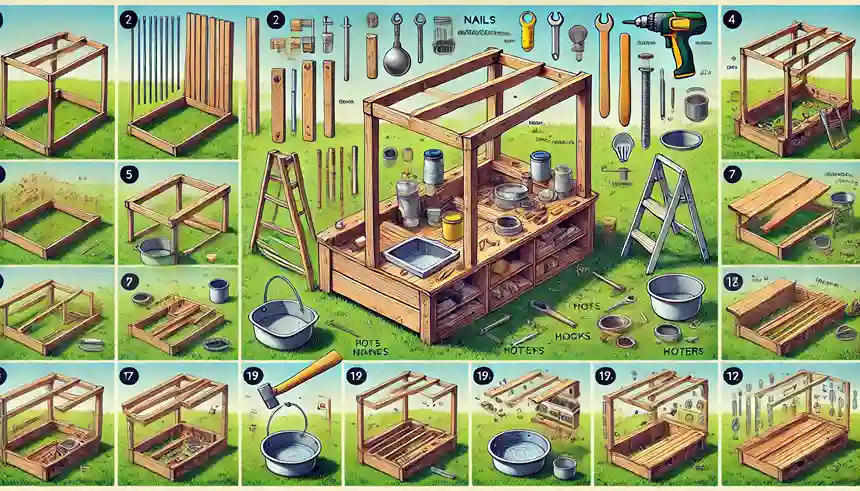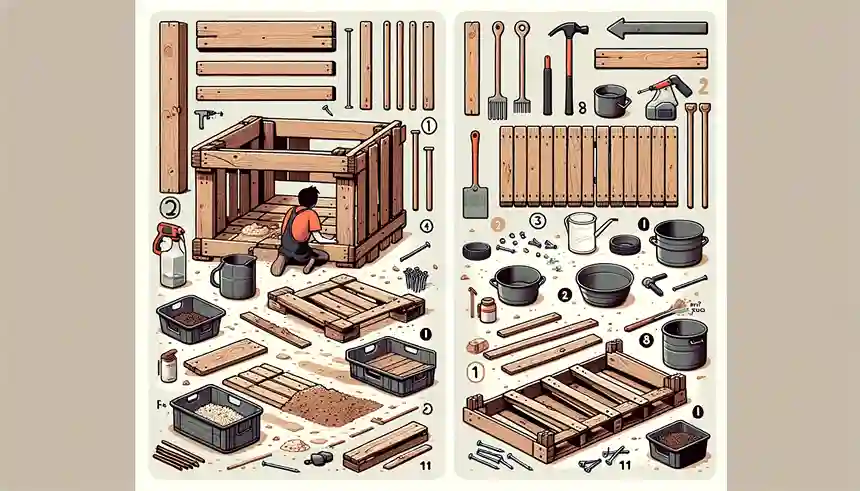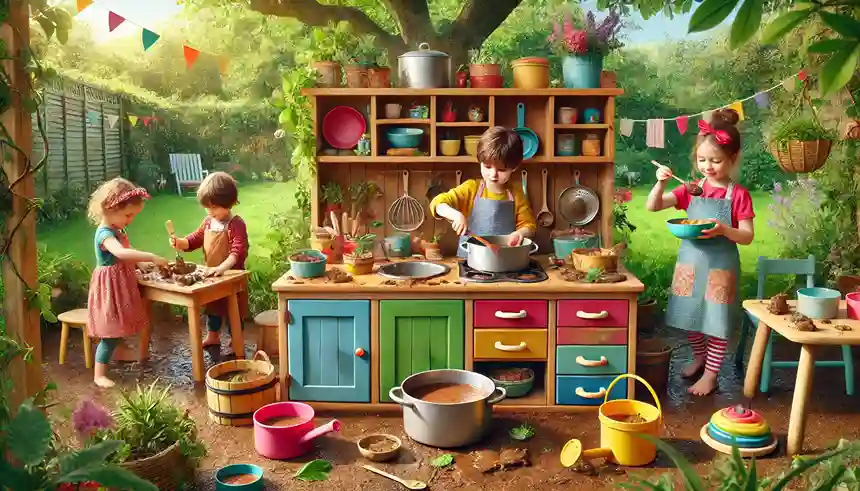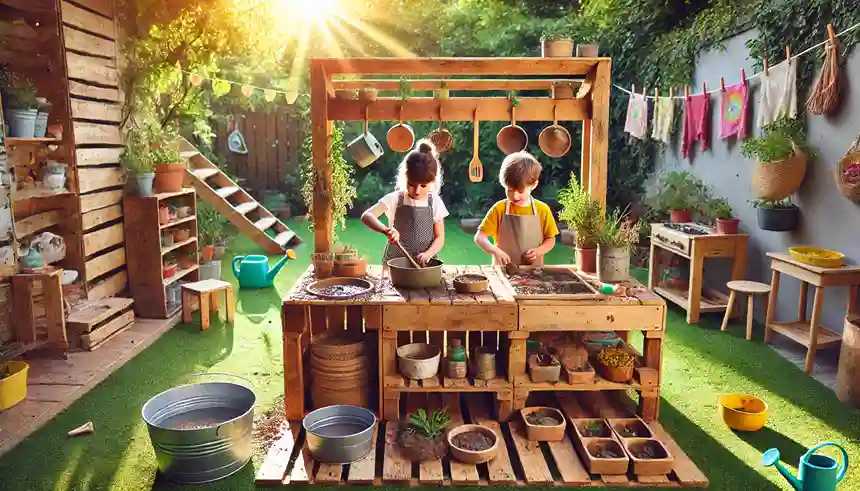Playing outdoors comes naturally to children, and there are plenty of things to keep them occupied, engage their imagination, and of course, get a little messy! For those wishing to combine fun with learning in the backyard, creating a diy mud kitchen would be a good idea.
In this step-by-step article, we will take you through all the details including where to source materials from to create the perfect DIY mud kitchen and its benefits for creative play. We will also detail why mud kitchens are not just entertaining but also extremely effective for a child’s development and learning. Let us begin with the goal of making the best play kitchen for children.
What are the Benefits Of Having A Diy Mud Kitchen for Kids?
But before we get to all the ‘how to’s, let’s first examine why making the outdoors mud kitchen is a very good idea for kids. Naturally, mud kitchens provide a way for your kids to get messy, but that is not their only purpose. They are great for sensory growth, imagination and creativity, and education.
- Sensory Play and Development
Engaging in sensory play is critical in early childhood development. It entails using the senses of touch, sights, sounds, and sometimes, one’s sense of smell, taste and balance. With a DIY mud kitchen, children can touch different forms of clay or mud, mud, sand and leaves, and can play with water and see how it affects the mud (in terms of its clarity).
Studies indicate that sensory play facilitates the development of pathways in the brain, which advances the development of thought, language and hand-eye coordination. Kids are able to develop concepts and ideas that may seem obscure when they are playing with mud to make pies, mixing leaves to make a soup or baking cakes that don’t exist.
- Encourages Outdoor Play
In an era where children are glued to various gadgets and appliances, it is imperative to foster outdoor play. A DIY mud kitchen makes it more exciting for children to be outdoors as it not only engages them in nature, but it makes them active. It encourages physical exercises and being active improves concentration, enhances creativity, and the overall state of being. Children who play outdoors in nature tend to be less stressed and tend to report higher levels of happiness.
- Creative and Imaginative Play
As we may have already mentioned, mud kitchens foster free play which is great for inciting creativity and imagination in children. Children can act out different roles such as chefs making mud pies, bakers making leaf cakes or even scientists experimenting with nature. There are no rules, no limits of any sort, and the only restrictions are those of your child’s imagination.
- Enhances Fine and Gross Motor Skills
The different physical activities performed in the mud kitchen, such as stirring, pouring, or scooping, ensure that the child’s fine motor skills develop. For instance, activities such as bending, squatting, stretching and reaching out to gather materials from the garden or around the yard facilitate the development of gross motor skills.
- Fosters Social Skills
A DIY mud kitchen can also promote social interaction if your kid has siblings or friends with whom they are playing. Through this social activity, children are able to learn about concepts such as sharing, turn taking, communication, and problem solving. Both of these situations help children learn important social skills including deciding who will stir the pot or how to construct the perfect mud pie.

Must-Have Tools and Materials for a Diy Mud Kitchen
A third of the cost of building a DIY mud kitchen is for materials. Here’s the good news: you can build the majority of a DIY mud kitchen with little or no cost because you can use old, cheap, recycled, or upcycled materials or make almost everything yourself! It’s a great way to save money while engaging in eco-friendly activities.
For the mud kitchen adults will need certain materials and tools, here’s a list of materials and tools you will need for the mud kitchen.
Essential Materials:
Old table or wooden pallets for the base: Shelves and countertops can be made of crates or wooden planks Pots and pans and wooden spoons (get these from older cooking items) Basins or buckets: Small jars filled with sand, stones, or leaves: Nails, hooks and screws: Wood sealant or outdoor paint: Optional Accessories: While pretending to operate Dave’s mud kitchen tools are impressive. With his imagination, children can have his fun with them as they mix “ingredients” in their mud kitchen. They can be a great distraction and prolong the experience of making mud pies. Children can also cook in the kitchen with play food and make it look as if they are dining in a restaurant. Gardening tools: miniature spades With miniature trowels it would be entertaining for children to be able to ‘harvest’ plants, flowers, and other ingredients to prepare plans for the kitchen.
Chalkboard or signs: Make the outdoor kitchen more interesting by putting up sections, organizing available specialties or naming the kitchen.
Natural materials: Use sand, small stones, twigs, leaves and petals in your son or daughter’s cooking recipes.
Tools:
Drill or screw driver (for the final touch of the structure)
Sandpaper (this is to eliminate edges that cut poorly finished wood)
Saw (in case wood has to be cut)
Measure tape (degree of accuracy is vital for the final assembly)
Directions to Build the Do It Your Self Diy Mud Kitchen
When you have procured the materials and tools, you can commence construction for the mud kitchen. It has never been easier to turn your imagination into reality. All you need to do is, adhere to these steps.
Step 1: Pick the best Area
Begin by outlining the most suitable area in which you want your mud kitchen to be built in. You need a space which is unbroken, secure and most importantly, does not get too much sun. It would be an advantage as well if it is located close to a garden hose or any other water supply because mud play will require a lot of water. It is important that the area is not too clean as children practicing in a mud kitchen will make everything wet and messy.
Step 2: Construct the Base of the Kitchen
Repurposed appliances such as a desk or stacked pallets give a more easy to make mud kitchen base. You can cut pallets and assemble them as a table in a way that it will be a safe working table for children. Use nails to join these cuts into one solid structure. In case an antique table is used, wipe it with sand paper and then smear paint or varnish on it.
Step 3: Use Wooden Plank Shelves
A well-designed mud kitchen also enables storage for the pots, pans, and other tools your child will be utilizing. Use wooden blocks or wooden crates and glue those onto the base to form shelving. Space these shelves for mixing bowls and possibly some pots for cooked items, or containers with materials gathered from nature such as rocks, branches, or foliage.
Step 4: Put Adjustable Hooks
A mud kitchen doesn’t need to be complicated and hooks are an easily overlooked feature. Place some along the edge of the kitchen for you to hang spoons, spatulas, or other kitchen utensils. This will improve the organization of the space allowing your children to access the toys better.
Step 5: Make Changes to the Appearance
This part is more fun! Involve your children in modifying their mud kitchen by allowing them to paint the furniture in bright colors or apply some fun decorations such as stencils, flowers, or even write their names on them. If you want to, you can make it a themed mud kitchen, maybe a pirate ship one or a fairy tale one.
Suggestions for further imaginative activities related to the construction of the diy mud kitchen and the children’s diy mud kitchen
As soon as the mud kitchen is done, the real fun begins! Here are a few of the activities that are imaginative and fun that your children can try out in their new mud kitchen:
- The Mud Pie Bakery Let us start with the idea of a bakery but specifically a mud pie bakery. Kids will definitely enjoy creating a pretend mud pie bakery using mud, water and leaves to create pies, cakes and many other delicious pretend sweet treats. For extra creativity, they can put flowers or pebbles on their creations.
- Development of ‘nature soup’ The children could for example decide to be head chefs in a high class restaurant and therefore have a recipe of ‘nature soup’. Allow the children to mix water and mud into a pot and add leaves, flowers and tiny sticks. Stirring and mixing different materials together offers great sensory exploration.
- Cooking with Seasons One of the highlights of a DIY mud kitchen is its adaptability to different seasons. During fall, your children may make a stew of leaves and acorns while in spring, they may use newly sprouted flowers for their mud pies. During winter, snow can be turned into snow “ice creams” or icy snow soups. The variations to mud applications are indeed limitless! 4. Muddy Tea Parties Your child’s mud kitchen also serves as the ideal location for tea parties of their imaginations. Let them play host to their dolls or teddy bears or friends and serve “tea” made from mud and “snacks” made from some other dirt delicacies. This does not only support imagination but also gets children to engage in social interactions and role playing. 5. Science Experiments Mud kitchens are not restricted to making meals only! Employ the area as a science laboratory where your children can carry out various tests and experiments. For instance what happens when they combine dry sand with water? What if they mixed in leaves or pebbles? Such activities are very good in enhancing cognitive learning and problem solving capabilities.

Instructions for the Maintenance and Improvements of the DIY Mud Kitchen
In order to keep the mud kitchen a clean and fun area for playing, one has to do some maintenance. Here are some suggestions to maintain the DIY mud kitchen at the best:
- Moisture Protection
In case your kitchen is wooden in construction, it is mandatory to prevent the wood from damage by the outdoors. Put some outdoor wood sealer on top of the wood to avoid it rotting or getting ruined by weather conditions. This is more of a concern if the kitchen will be kept outside for a long duration.
- Maintenance of Hygiene
Mud kitchens are intended to be messy and unkempt but that does not mean no cleaning needs to be done in order to ensure the kitchen lasts. After pretend play, one should instruct the child to wash the pots, pans, and utensils as well as the areas that the child touched. This routine will prevent any accumulation of mud and all devices will be functioning properly.
- Changing raw materials for the kitchen
Change raw materials and kitchen utensils frequently so as not to make the mud kitchen dull. You can use other natural materials like other types and varieties of leaves, flowers or even tiny rocks and shells. This change of material makes the child not only stay focused but also encourages the child’s imagination.
- Seasonal Decorations
Transform the aesthetic of the mud kitchen by theming it to any seasons or events as this will change the monotony. For instance, during autumn, you may use pumpkins as well as leaves, while putting snowflake musical boxes at winter. Such changes improve the play area without being boring over time.
Advanced DIY Ideas: Taking Your Diy Mud Kitchen to the Next Level
If you’re feeling a bit more creative, there are great opportunities to push your creativity even further with your DIY mud kitchen by incorporating some more intricate fun ideas. These additions will improve the efficiency and the enjoyment from the mud kitchen during playtime even more:
- Add a Working Water Pump
Adding a manual water pump can be a great boost. This lets children pump water straight into their pots and bowls, making the kitchen more realistic and adding an element of excitement regarding clean up after their play.
- Establish a Water Recycling System
The construction of a water recycling system can further enhance the sustainability aspects of the mud kitchen. Underneath a working sink, place a basin where the water runs off and devise a method on how that water can be utilized during play. This not only instructs the children on the conserving water, but ensures there is enough water for the cooking activities as well.
- Fix a ‘Real’ Oven
Mud kitchen may not have an active oven but you can somewhat fake it by providing an illusion of a wood or brick oven. Construct, paint and deploy fake doors and knobs as the children will be using the oven in their kitchens. Children will enjoy authenticating their kitchen because it will make them feel like they are using a real diy mud kitchen.

The Educational and developmental benefits of a DIY Mud Kitchen
Some of the benefits of diy mud kitchen traditions have already interrupted this narrative but it would be worthwhile to do this with regard to more profound issues. They claim that a diy mud kitchen which is made by parents or mothers is filled with several educational and developmental benefits for the children.
- Promotes STEM Learning
Building or even experimenting is an important problem-solving activity in learning science, technology, engineering, and mathematics (STEM). For example, if a child is measuring water, mixing different types of mud with sand and creating recipes, this child is actually learning basic science and math in a playful situation.
- Fosters Early Literacy
Children role-play and tell stories about people and situations, so a diy mud kitchen activity usually does not lack participants impersonating restaurant owners, chefs, or scientists. Moreover, in joining this type of play, children practice language in different forms, for example vocabulary, communication, and some emerging literacy.
- Emotional Growth
Messy play could also be seen to be beneficial to children’s therapeutical aspect. It enables a child to have room for self-expression where he or she is able to deal with emotions in a positive manner. Stress relief and emotional comfort can be brought about by a child constructing something by hand and being messy.
Conclusion
Making a DIY mud kitchen is also among the best ways for your child to play outdoors while gaining different skills. Simple or even complex diy mud kitchens complete with several fun additional components will allow children to play creatively outdoors for hours.
A diy mud kitchen will not just provide an opportunity for their physical development in areas of both fine and gross motor movements, it will also assist them in developing more creativity, socialization and problem-solving aspects. It’s also a great project that’s inexpensive, fun, and allows you use your imagination with what materials you have, as it’s mostly recyclable!
So, why not? Take out what you need, find a place in your garden and make your own diy mud kitchen in the form of a DIY project!

